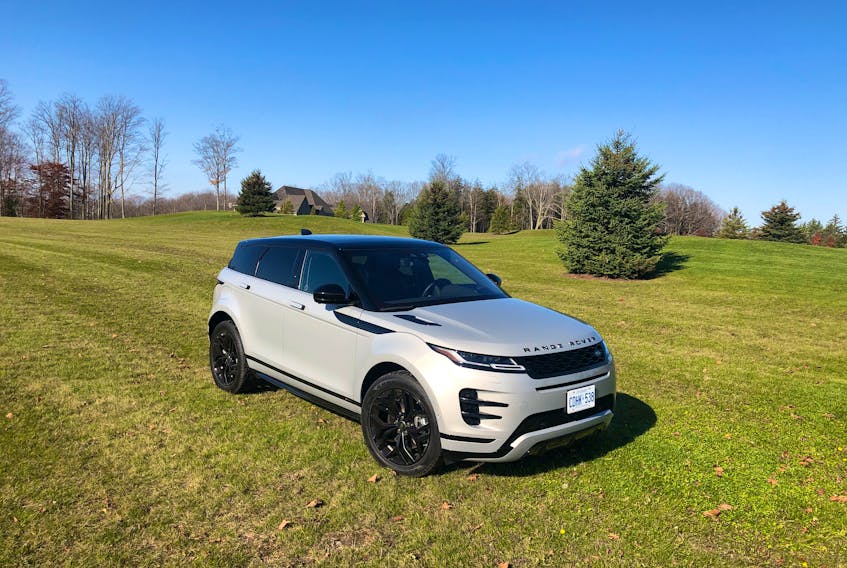When Range Rover unleashed the Evoque in 2011 as a 2012 model, the unique style stood out among the few luxury utility vehicles on the market at that time. Eight model years later, after very little change, it continued to stand out in a field of competitors that more than tripled in the interim.
Now we have a second-generation Evoque. At first glance, the 2020 model does not appear to have changed much. The signature sloping roofline remains the most distinctive feature. Look more closely though and you’ll see a number of small details, chief among them flush-mounted door handles and a cleaner finish around the windshield and side windows.
The rearward leaning grill is flanked by a pair of slim headlights. The pronounced beltline rises from front to back while the roofline drops along its length. The resulting slim rear windows and poor visibility from within remain.
The result is an ultra-clean look, more like a show car than a production version. This is perhaps the most stylish ute on the market.
The changes go deeper, so deep the company claims only the door hinges are carried over from the outgoing model. It starts with a new platform, developed with the future in mind. The original Evoque was based on a lightly-revised base used for the LR2. The new Premium Transverse Architecture has been designed to accommodate not only conventional, but hybrid and plug-in hybrid powertrains. It can be found beneath a variety of Jaguar-Land Rover vehicles, including the Jaguar E-Pace, Range Rover Velar and Land Rover Discovery Sport.
The shadow cast by the second generation of Land Rover’s entry level model is almost identical to its predecessor. Despite little changes in exterior dimensions, the new platform and excellent work by the interior team has brought significant improvements in passenger and cargo capacity, both of which were in short supply previously. There is an additional 21 mm of knee room in the rear seat, and six per cent more cargo area. The center console is larger, as is the storage bin within.
In addition to the modernistic design, there are a number of refinements compared to the outgoing model. New mounting points for the supportive front seats leave more room beneath for rear passenger feet. Two big digital touchscreens dominate the centre stack. There is a sliding armrest atop the center console, and provision for water bottles etc. in the bottom of the front doors.

The finish is a mixture of supple leather, brushed metallic accents and glossy plastic, perhaps a little too much of the latter. To address limited visibility out of the shallow rear and sharply sloped side windows, the Evoque is available with what the company refers to as a "ClearSight" rear view mirror. First seen on Cadillac models a few years back, it utilizes cameras to provide an unobstructed view to the rear. I’m not a big fan, but it does help if the rear seat is occupied by tall people or the cargo area is stacked high.
A more useful technology is the "ClearSight Ground View" system. It uses cameras in the grill and beneath the mirrors to provide a view under the front of the Evoque. It is meant to help manoeuver in tight spots and prevent striking or high-centering on objects off road. But arguably more important, and certain to be used more often, is the ability to avoid scraping the front valance when parking nose-first into curbs or concrete bollocks.
Off-roading is part of the Land Rover DNA, so the Evoque is equipped to do it better than most. It boasts the second generation of Range Rover’s effective Terrain Response 2 technology. Designed to automatically detect the surface and adjust the vehicle’s systems, it allows the drivers to venture much further off the beaten path than 99 per cent of Evoque drivers will ever attempt.
They will more likely find use of the suite a suite of drive modes that custom tailor the driveline for sand, snow, gravel and mud encounters. If they do attempt rock crawling or fording deep streams the Evoque offers 21 cm of ground clearance, a 25-degree approach angle and the ability to wade through 60 cm of water.
Power, an adequate amount, but not more, is provided by a turbocharged Jaguar/Land Rover 2.0-litre, four-cylinder engine paired with a nine-speed automatic transmission from ZF.
On the road, the Evoque is quiet and composed. The stiff new architecture shows here. I did not attempt any off-road work. Previous experience with Land Rover products in serious conditions left little doubt the Evoque could outperform all but a few competitors.
The Evoque is a stylish and comfortable crossover.
The specs
Model: 2020 Range Rover Evoque R-Dynamic P300 HSE
Engine: turbocharged, 2.0-litre, four-cylinder, 296 horsepower, 295 lb.-ft. of torque, premium fuel recommended.
Transmission: nine-speed automatic
NRCan rating (litres/100km city/highway): 11.4 / 8.9
Length: 4,371 mm
Width: 2,100 mm
Wheelbase: 2,681 mm
Weight: 1,893 kg
Price: $62,500 base, $67,050 as tested, plus freight
Competition: Audi Q3, BMW X11474, Mercedes-Benz GLA, Volvo XC40
Options on test vehicle: Seoul pearl silver paint, $800; Black exterior package (hood script, grill, bumper, vents, mirror caps, exhaust tips, tailgate script), $800; 20-inch gloss black wheels, $500; fixed panoramic sunroof, $1,300; Homelink, $200; Harmon Kardon audio system, $950
RELATED:









